Optimization of Ammonia Nitrogen and Phosphorus Removal Performance and Analysis of Microbial Community Structure in Microbial Fuel Cells
Abstract
1. Introduction
2. Materials and Methods
2.1. Experimental Facility
2.2. Wastewater
2.3. PEM and Electrode Pretreatment
2.4. Modeling and Optimization
2.5. Methods for Wastewater Quality Testing and Microbial Sequencing
3. Results and Discussion
3.1. Construction and Optimization of NH4+-N Removal Rate Model
3.1.1. Analysis of Variance and Validation of the NH4+-N Removal Model
3.1.2. Effect of the Interaction of Factors and Optimization of the System
3.2. Construction and Optimization of TP Removal Rate Model
3.2.1. Analysis of Variance and Validation of the TP Removal Rate Model
3.2.2. Analysis of Variance and Validation of the TP Removal Rate Model
3.3. Optimization of the System and Verification of the Model
3.4. Analysis of Microbial Diversity and Community Structure
3.4.1. Microbial Diversity Analysis of Each System
3.4.2. Analysis of Microbial Community Structure
4. Conclusions
- (1).
- The F-value of the fitted model for removing NH4+-N was 16.33, which showed that the model had a good effect, and the p-value was less than 0.0001, which showed that the model was reliable. The value of coefficient variation (C.V.) was 11.59%, and the signal-to-noise ratio was 11.90 (>4), which proved that the test had a high accuracy. The R2 of the fitted model was 0.77, the adjusted R2 was 0.72 and the predicted R2 was 0.53, indicating the rationality of the model construction. Two factors had a significant influence on the removal of NH4+-N; the effect of the initial influent ammonia concentration was greater than that of the HRT.
- (2).
- The F-value of the fitted model for removing TP was 41.97, indicating that the model had a good effect, and the p-value was less than 0.0001, indicating that the model was reliable. The value of coefficient variation (C.V.) was 4.26%, and the signal-to-noise ratio was 16.07 (>4), which proved that the test had a high accuracy. The R2 of the fitted model was 0.97, the adjusted R2 was 0.95 and the predicted R2 was 0.78, indicating the rationality of the model construction. Two factors had a significant influence on the removal of TP; the effect of the initial influent ammonia concentration was greater than that of the HRT.
- (3).
- The results of the optimization and verification experiments showed that the actual removal rates of NH4+-N and TP in the optimized system were 94.88% and 59.39%, respectively (the predicted values were 90.18% and 56.25%), indicating that the expected experimental results were achieved and the accuracy of optimization of the constructed model was verified.
- (4).
- Changes in the structure of microorganisms and the community: after the optimization of the system operation parameters, the total number of species in the optimization group decreased, and the richness of the microbial community decreased. The system performed an orthoselection of the microbial community and optimized the structure of the microbial community. After the optimization, the dominant strains for NH4+-N and TP removal on the cathode reactor of each system were strengthened at the phylum and genus levels. Under the coaction of the dominant strains, the efficiency of nitrogen removal and phosphorus removal in the reactor was significantly improved.
Author Contributions
Funding
Acknowledgments
Conflicts of Interest
References
- Yang, N.; Zhou, Q.; Zhan, G.; Liu, Y.; Luo, H.; Li, D. Comparative evaluation of simultaneous nitritation/denitritation and energy recovery in air-cathode microbial fuel cells (ACMFCs) treating low C/N ratio wastewater. Sci. Total Environ. 2021, 788, 147652. [Google Scholar] [CrossRef] [PubMed]
- Sotres, A.; Cerrillo, M.; Viñas, M.; Bonmatí, A. Nitrogen removal in a two-chambered microbial fuel cell: Establishment of a nitrifying-denitrifying microbial community on an intermittent aerated cathode. Chem. Eng. J. 2016, 284, 905–916. [Google Scholar] [CrossRef]
- Ye, Y.; Ngo, H.H.; Guo, W.; Chang, S.W.; Nguyen, D.D.; Zhang, X.; Zhang, S.; Luo, G.; Liu, Y. Impacts of hydraulic retention time on a continuous flow mode dual-chamber microbial fuel cell for recovering nutrients from municipal wastewater. Sci. Total Environ. 2020, 734, 139220. [Google Scholar] [CrossRef]
- Liu, S.; Feng, X.; Xue, H.; Qiu, D.; Huang, Z.; Wang, N. Bioenergy generation and nitrogen removal in a novel ecological-microbial fuel cell. Chemosphere 2021, 278, 130450. [Google Scholar] [CrossRef] [PubMed]
- Samudro, G.; Imai, T.; Hung, Y.T. Enhancement of Power Generation and Organic Removal in Double Anode Chamber Designed Dual-Chamber Microbial Fuel Cell (DAC-DCMFC). Water 2021, 13, 2941. [Google Scholar] [CrossRef]
- Shahi, A.; Chellam, P.V.; Verma, A.; Singh, R.S. A comparative study on the performance of microbial fuel cell for the treatment of reactive orange 16 dye using mixed and pure bacterial species and its optimization using response surface methodology. Sustain. Energy Technol. Assess. 2021, 48, 101667. [Google Scholar] [CrossRef]
- Almatouq, A.; Babatunde, A.O. Identifying optimized conditions for concurrent electricity production and phosphorus recovery in a mediator-less dual chamber microbial fuel cell. Appl. Energy 2018, 230, 122–134. [Google Scholar] [CrossRef]
- Hassan, H.; Jin, B.; Dai, S. Dual-Response Quadratic Model for Optimization of Electricity Generation and Chlorophenol Degradation by Electro-Degradative Bacillus subtilis in Microbial Fuel Cell System. Environ. Technol. 2021, 43, 2867–2880. [Google Scholar] [CrossRef]
- Zhang, G.; Lee, D.J.; Cheng, F. Treatment of domestic sewage with anoxic/oxic membrane-less microbial fuel cell with intermittent aeration. Bioresour. Technol. 2016, 218, 680–686. [Google Scholar] [CrossRef] [PubMed]
- Rodrigo, V.L.; Jorge, D.M.; Ernesto, R.L.; Gabriel, P.; Alfonso, C.H.; Alfredo, M.; Diana, D.R.; Rodrigo, M.C.; Gerardo, C.; Carlos, G.B.; et al. Scale up of Microbial Fuel Cell Stack System for Residential Wastewater Treatment in Continuous Mode Operation. Water 2019, 11, 217. [Google Scholar] [CrossRef]
- Goto, Y.; Yoshida, N. Scaling up Microbial Fuel Cells for Treating Swine Wastewater. Water 2019, 11, 1831. [Google Scholar] [CrossRef]
- Zhou, Y.; Zhu, N.; Guo, W.; Wang, Y.; Huang, X.; Wu, P.; Dang, Z.; Zhang, X.; Xian, J. Simultaneous electricity production and antibiotics removal by microbial fuel cells. J. Environ. Manag. 2018, 217, 565–572. [Google Scholar] [CrossRef]
- Sadabad, H.R.; Gholikandi, G.B. Simultaneous effective sludge stabilization and direct electricity generation by merging microbial fuel cell (MFC) and Fered-Fenton reactor: An experimental study. Biomass Bioenergy 2018, 119, 75–89. [Google Scholar] [CrossRef]
- Geetanjali; Rani, R.; Sharma, D.; Kumar, S. Optimization of operating conditions of miniaturize single chambered microbial fuel cell using NiWO4/graphene oxide modified anode for performance improvement and microbial communities dynamics. Bioresour. Technol. 2019, 285, 121337. [Google Scholar] [CrossRef] [PubMed]
- Salar-García, M.J.; Ramón-Fernández, A.; Ortiz-Martínez, V.M.; Ruiz-Fernández, D. Towards the optimisation of ceramic-based microbial fuel cells: A three factor three-level response surface analysis design. Biochem. Eng. J. 2019, 144, 119–124. [Google Scholar] [CrossRef]
- Tao, Q.; Luo, J.; Zhou, J.; Zhou, S.; Liu, G.; Zhang, R. Effect of dissolved oxygen on nitrogen and phosphorus removal and electricity production in microbial fuel cell. Bioresour. Technol. 2014, 164, 402–407. [Google Scholar] [CrossRef]
- Zhao, H.; Kong, C.H. Enhanced removal of p-nitrophenol in a microbial fuel cell after long-term operation and the catabolic versatility of its microbial community. Chem. Eng. J. 2018, 339, 424–431. [Google Scholar] [CrossRef]
- Feng, Y.; Long, Y.; Wang, Z.; Wang, X.; Shi, N.; Sou, N.; Shi, Y.; Yu, Y. Performance and microbial community of an electric biological integration reactor (EBIR) for treatment of wastewater containing ibuprofen. Bioresour. Technol. 2019, 274, 447–458. [Google Scholar] [CrossRef] [PubMed]
- Sugumar, M.; Dharmalingam, S. Statistical optimization of process parameters in microbial fuel cell for enhanced power production using Sulphonated Polyhedral Oligomeric Silsesquioxane dispersed Sulphonated Polystyrene Ethylene Butylene Polystyrene nanocomposite membranes. J. Power Sources 2020, 469, 228400. [Google Scholar] [CrossRef]
- Lu, N.; Zhou, S.G.; Zhuang, L.; Zhang, J.T.; Ni, J.R. Electricity generation from starch processing wastewater using microbial fuel cell technology. Biochem. Eng. J. 2009, 43, 246–251. [Google Scholar] [CrossRef]
- Hiegemann, H.; Lübken, M.; Schulte, P.; Schmelz, K.G.; Gredigk, S.; Wichern, M. Inhibition of microbial fuel cell operation for municipal wastewater treatment by impact loads of free ammonia in bench- and 45L-scale. Sci. Total Environ. 2018, 624, 34–39. [Google Scholar] [CrossRef] [PubMed]
- Nama, J.Y.; Kim, H.W.; Shin, H.S. Ammonia inhibition of electricity generation in single-chamber microbial fuel cells. J. Power Sources 2010, 195, 6428–6433. [Google Scholar] [CrossRef]
- Akman, D.; Cirik, K.; Ozdemir, S.; Ozkaya, B.; Cinar, O. Bioelectricity generation in continuously-fed microbial fuel cell: Effects of anode electrode material and hydraulic retention time. Bioresour. Technol. 2013, 149, 459–464. [Google Scholar] [CrossRef] [PubMed]
- Sobieszuk, P.; Zamojska-Jaroszewicz, A.; Makowski, Ł. Influence of the operational parameters on bioelectricity generation in continuous microbial fuel cell, experimental and computational fluid dynamics modelling. J. Power Sources 2017, 371, 178–187. [Google Scholar] [CrossRef]
- Yousefi, V.; Mohebbi-Kalhori, D.; Samimi, A.; Salari, M. Effect of separator electrode assembly (SEA) design and mode of operation on the performance of continuous tubular microbial fuel cells (MFCs). Int. J. Hydrogen Energy 2016, 41, 597–606. [Google Scholar] [CrossRef]
- Pinto, R.P.; Srinivasan, B.; Guiot, S.R.; Tartakovsky, B. The effect of real-time external resistance optimization on microbial fuel cell performance. Water Res. 2011, 45, 1571–1578. [Google Scholar] [CrossRef] [PubMed]
- Yang, N.; Liu, H.; Zhan, G.Q.; Li, D. Sustainable ammonia-contaminated wastewater treatment in heterotrophic nitrifying/denitrifying microbial fuel cell. J. Clean. Prod. 2020, 245, 118923. [Google Scholar] [CrossRef]
- Koffi, N.J.; Okabe, S. Effect of poised cathodic potential on anodic ammonium nitrogen removal from domestic wastewater by air-cathode microbial fuel cells. Bioresour. Technol. 2022, 348, 126807. [Google Scholar] [CrossRef] [PubMed]
- Naseer, M.N.; Zaidi, A.A.; Khan, H.; Kumar, S.; Owais, M.T.; Wahab, Y.A.; Dutta, K.; Jaafar, J.; Hamizi, N.A.; Islam, M.A.; et al. Statistical Modeling and Performance Optimization of a Two-Chamber Microbial Fuel Cell by Response Surface Methodology. Catalysts 2021, 11, 1202. [Google Scholar] [CrossRef]
- Zhou, R.J.; Zhang, M.; Li, J.Y.; Zhao, W. Optimization of preparation conditions for biochar derived from water hyacinth by using response surface methodology (RSM) and its application in Pb2+ removal. J. Environ. Chem. Eng. 2020, 8, 104198. [Google Scholar] [CrossRef]
- Sadabad, H.R.; Gholikandi, G.B.; Rad, H.A.; Sadabad, H.R. Optimizing hybrid microbial fuel cell (MFC) and aerobic digestion reactor to gain simultaneous electricity generation and effective sludge digestion: An experimental study, mathematical modeling and recent achievements. Desalin. Public 2021, 212, 87–102. [Google Scholar]
- Mahmoudi, A.; Mousavi, S.A.; Darvishi, P. Effect of ammonium and COD concentrations on the performance of fixed-bed air-cathode microbial fuel cells treating reject water. Int. J. Hydrogen Energy 2020, 45, 4887–4896. [Google Scholar] [CrossRef]
- EPA of China. Monitoring and Analysis Methods of Water and Wastewater; China Environmental Science Press: Beijing, China, 2002. [Google Scholar]
- Li, L.; Zhang, J.; Tian, Y.; Zhan, W.; Lin, Q.; Li, H.; Zuo, W. Optimization of nutrient removal of novel electrochemically active carriers by response surface methodology. Bioresour. Technol. 2019, 292, 122000. [Google Scholar] [CrossRef] [PubMed]
- Li, C.; Yang, J.; Wang, X.; Wang, E.; Li, B.; He, R.; Yuan, H. Removal of nitrogen by heterotrophic nitrification-aerobic denitrification of a phosphate accumulating bacterium Pseudomonas stutzeri YG-24. Bioresour. Technol. 2015, 182, 18–25. [Google Scholar] [CrossRef] [PubMed]
- M’rassi, A.G.; Bensalah, F.; Gury, J.; Duran, R. Isolation and characterization of different bacterial strains for bioremediation of n-alkanes and polycyclic aromatic hydrocarbons. Environ. Sci. Pollut. Res. 2015, 22, 15332–15346. [Google Scholar] [CrossRef] [PubMed]
- Arshad, A.; Martins, P.D.; Frank, J.; Jetten, M.S.; Camp, H.J.; Welte, C.U. Mimicking microbial interactions under nitrate-reducing conditions in an anoxic bioreactor: Enrichment of novel Nitrospirae bacteria distantly related to Thermodesulfovibrio. Environ. Microbiol. 2017, 19, 4965–4977. [Google Scholar] [CrossRef]
- Speris, L.B.M.; Rice, D.T.F.; Petrovski, S.; Seviour, R.J. The Phylogeny, Biodiversity, and Ecology of the Chloroflexi in Activated Sludge. Front. Microbiol. 2019, 10, 2015. [Google Scholar] [CrossRef] [PubMed]
- Johan, L.; Sara, M.L. Bacteroidetes bacteria in the soil: Glycan acquisition, enzyme secretion, and gliding motility. Adv. Appl. Microbiol. 2020, 110, 63–87. [Google Scholar] [CrossRef]
- Lidbury, I.D.; Borsetto, C.; Murphy, A.R.; Bottrill, A.; Jones, A.M.; Bending, G.D.; Hammond, J.P.; Chen, Y.; Wellington, E.M.; Scanlan, D.J. Niche-adaptation in plant-associated Bacteroidetes favours specialisation in organic phosphorus mineralization. ISME J. 2021, 15, 1040–1055. [Google Scholar] [CrossRef] [PubMed]
- Jung, S.; Regan, J.M. Comparison of anode bacterial communities and performance in microbial fuel cells with different electron donors. Appl. Microbiol. Biotechnol. 2007, 77, 393–402. [Google Scholar] [CrossRef]
- Wang, Y.; Pan, Y.; Zhu, T.; Wang, A.; Lu, Y.; Lv, L.; Zhang, K.; Li, Z. Enhanced performance and microbial community analysis of bioelectrochemical system integrated with bio-contact oxidation reactor for treatment of wastewater containing azo dye. Sci. Total Environ. 2018, 634, 616–627. [Google Scholar] [CrossRef] [PubMed]
- Su, J.F.; Yang, S.; Huang, T.L.; Li, M.; Liu, J.R.; Yao, Y.X. Enhancement of the denitrification in low C/N condition and its mechanism by a novel isolated Comamonas sp. YSF15. Environ. Pollut. 2020, 256, 113294. [Google Scholar] [CrossRef] [PubMed]
- Wang, Q.; Fu, W.; Lu, R.; Pan, C.; Yi, G.; Zhang, X.; Rao, Z. Characterization of Bacillus subtilis Ab03 for efficient ammonia nitrogen removal. Syst. Microbiol. Biomanuf. 2022, 2, 580–588. [Google Scholar] [CrossRef]
- Patil, M.P.; Jeong, I.; Woo, H.E.; Oh, S.J.; Kim, H.C.; Kim, K.; Nakashita, S.; Kim, K. Effect of Bacillus subtilis Zeolite Used for Sediment Remediation on Sulfide, Phosphate, and Nitrogen Control in a Microcosm. Int. J. Environ. Res. Public Health 2022, 19, 4163. [Google Scholar] [CrossRef]
- Tahir, N.; Asma, I.; Sohail, H.; Muhammad, S.; Afshan, M.; Javed, I.; Kashif, H.M.; Shaghef, E.; Abdullah, M.K. First report of diazotrophic Brevundimonas spp. as growth enhancer and root colonizer of potato. Sci. Rep. 2020, 10, 12893. [Google Scholar] [CrossRef]
- Liang, D.; He, W.; Li, C.; Yu, Y.; Zhang, Z.; Ren, N.; Feng, Y. Bidirectional electron transfer biofilm assisted complete bioelectrochemical denitrification process. Chem. Eng. J. 2019, 375, 121960. [Google Scholar] [CrossRef]
- Jiang, M.; Zheng, X.; Chen, Y. Enhancement of denitrification performance with reduction of nitrite accumulation and N2O emission by Shewanella oneidensis MR-1 in microbial denitrifying process. Water Res. 2020, 169, 115242. [Google Scholar] [CrossRef]
- Liu, X.; Chen, C.; Wang, J.; Zou, S.; Long, X. Phosphorus solubilizing bacteria Bacillus thuringiensis and Pantoea ananatis simultaneously promote soil inorganic phosphate dissolution and soil Pb immobilization. Rhizosphere 2021, 20, 100448. [Google Scholar] [CrossRef]
- Petriglieri, F.; Singleton, C.; Peces, M.; Petersen, J.F.; Nierychlo, M.; Nielsen, P.H. “Candidatus Dechloromonas phosphoritropha” and “Ca. D. phosphorivorans”, novel polyphosphate accumulating organisms abundant in wastewater treatment systems. ISME J. 2021, 15, 3605–3614. [Google Scholar] [CrossRef]
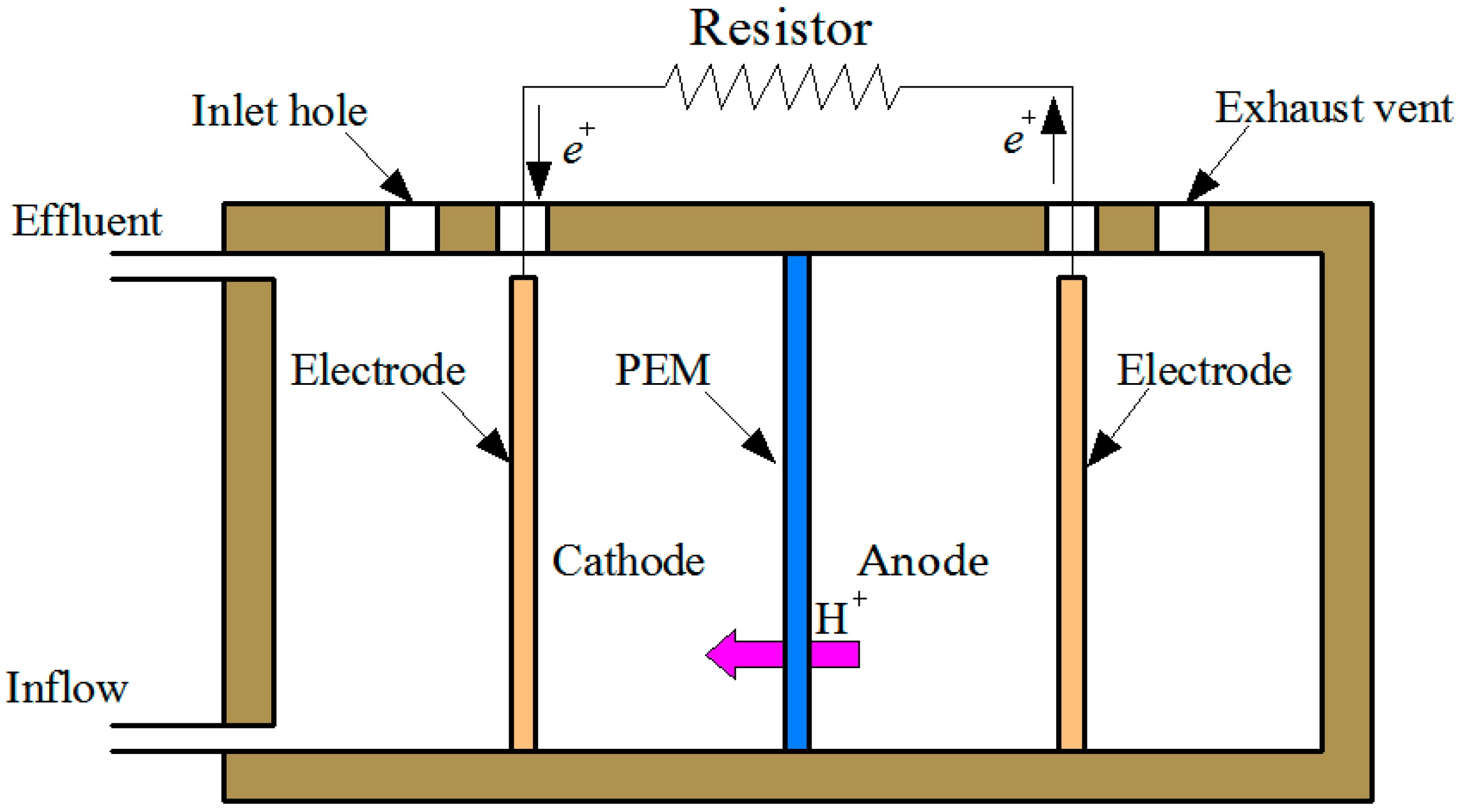
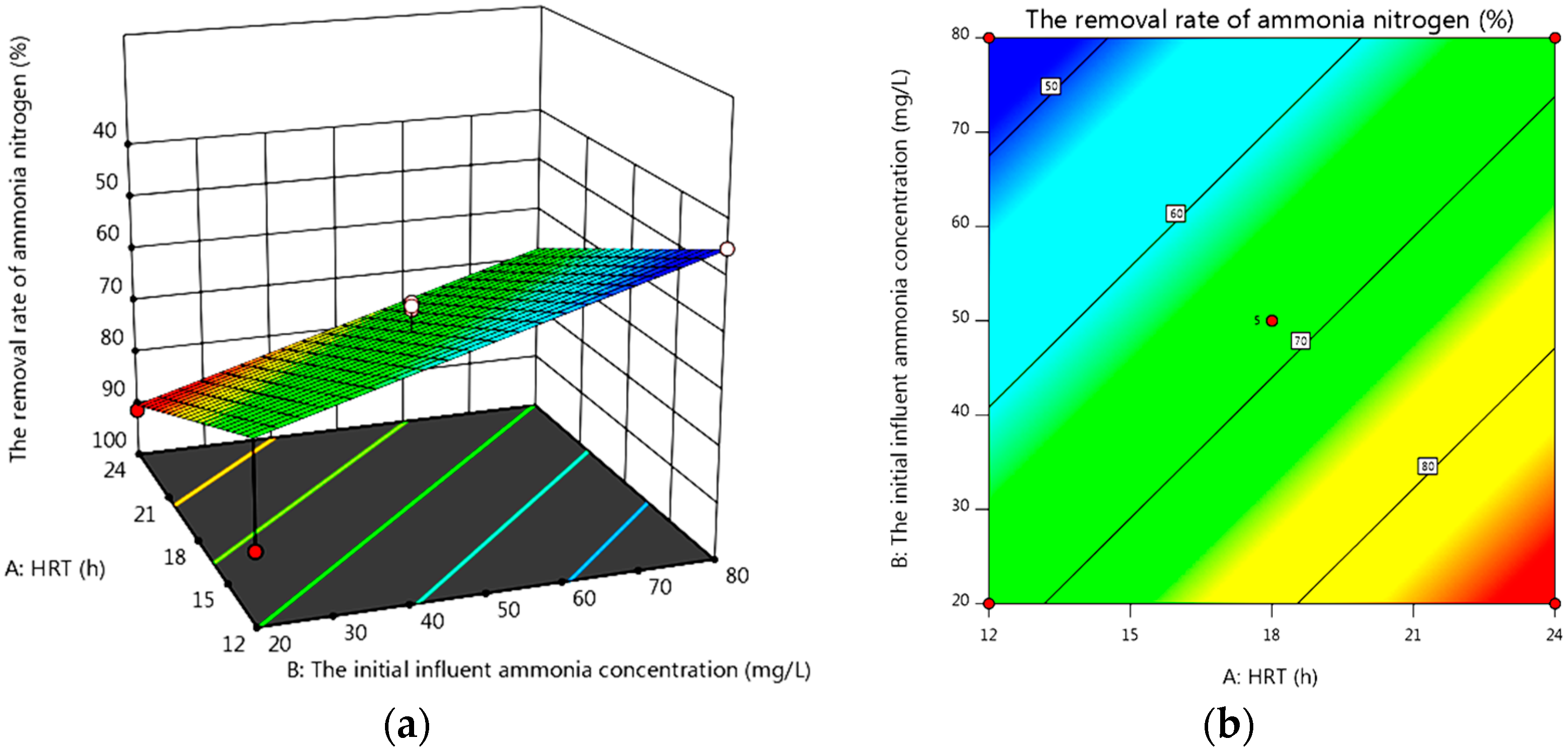
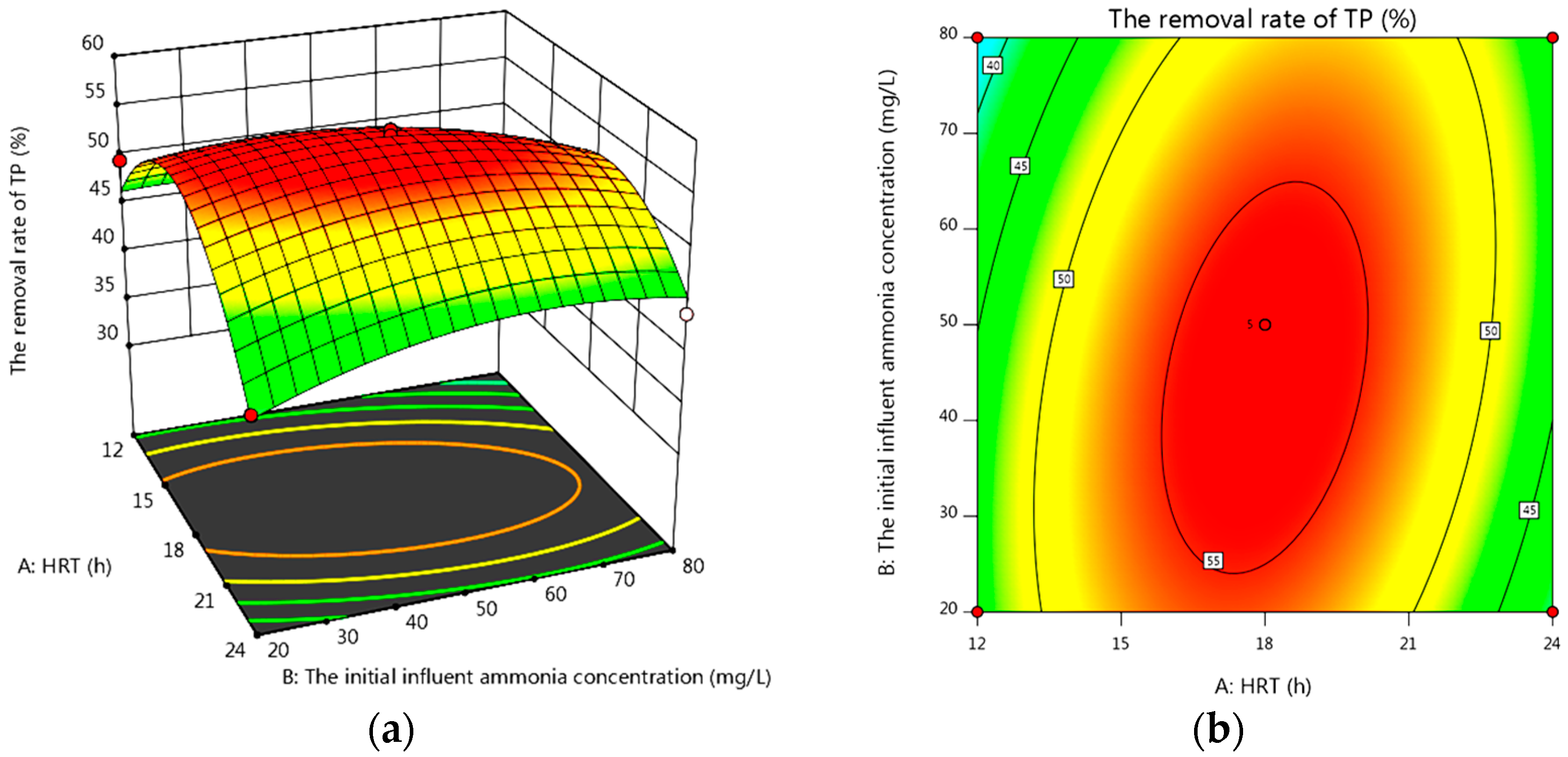
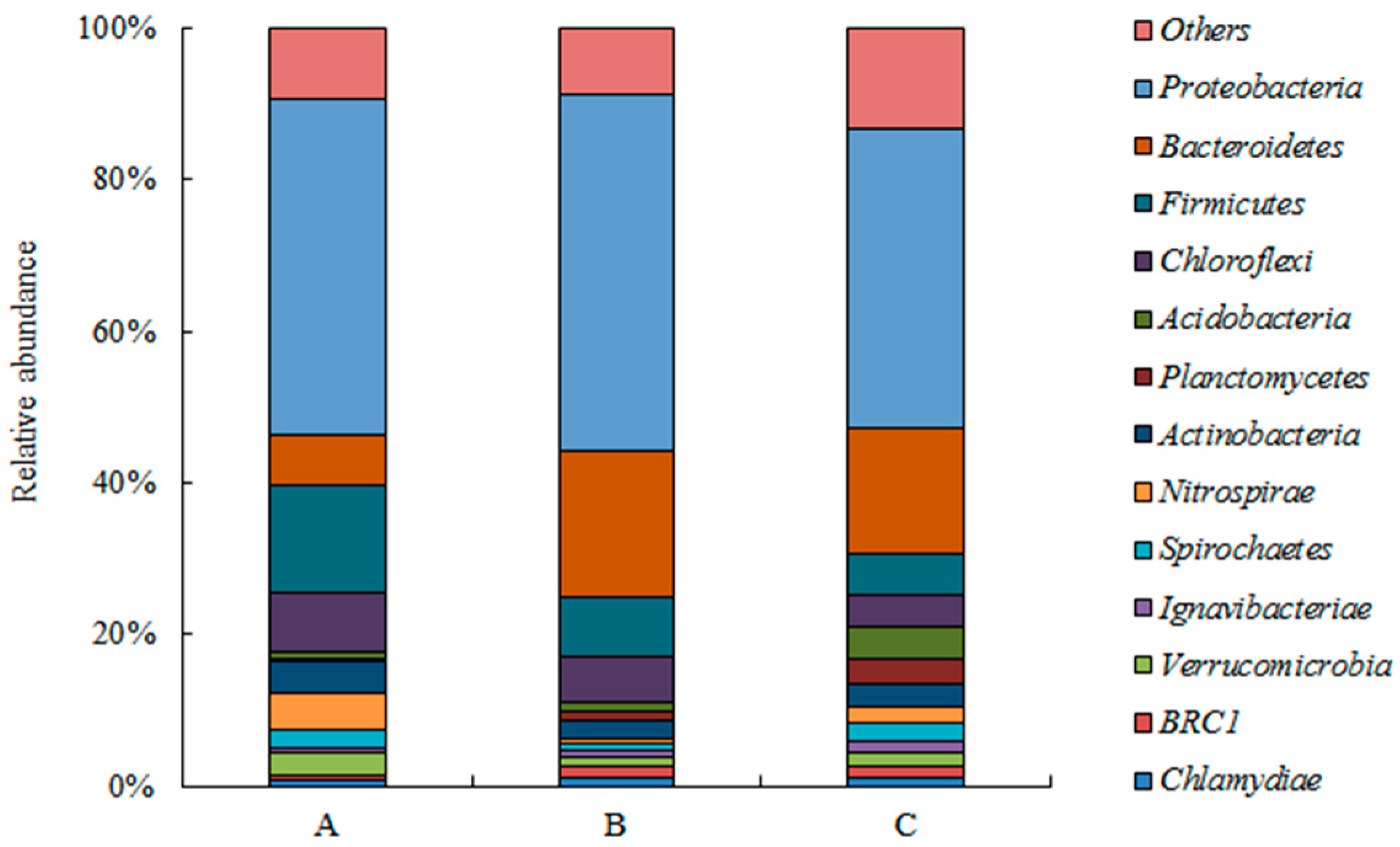
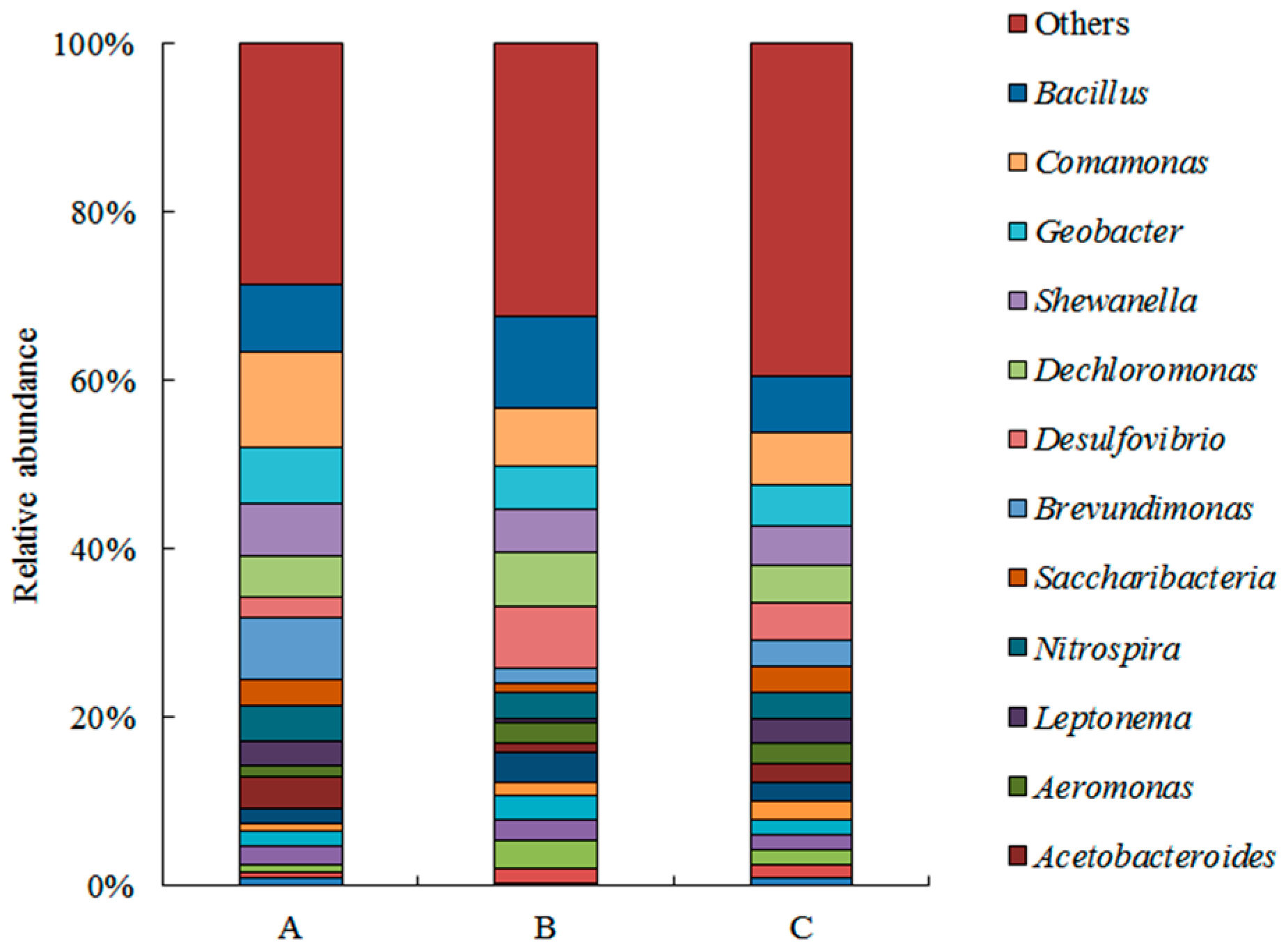
| Number | Factor | Unit | Code | Level | ||
|---|---|---|---|---|---|---|
| −1 | 0 | +1 | ||||
| 1 | HRT | h | X1 | 12 | 18 | 24 |
| 2 | initial influent ammonia concentration | mg/L | X2 | 20 | 50 | 80 |
| Factor 1 | Factor 2 | Response 1 | Response 2 | |
|---|---|---|---|---|
| Run | X1 | X2 | The Removal Rate of NH4+-N (Y1) | The Removal Rate of TP(Y2) |
| h | mg/L | % | % | |
| 1 | 9.52 | 50 (0) | 46.92 | 31.26 |
| 2 | 24 (+1) | 80 (+1) | 76.54 | 43.82 |
| 3 | 12 (−1) | 80 (+1) | 45.21 | 38.57 |
| 4 | 18 (0) | 50 (0) | 63.29 | 55.82 |
| 5 | 18 (0) | 50 (0) | 62.21 | 56.27 |
| 6 | 26.49 | 50 (0) | 84.97 | 36.82 |
| 7 | 24 (+1) | 20 (−1) | 91.24 | 41.26 |
| 8 | 12 (−1) | 20 (−1) | 86.92 | 49.53 |
| 9 | 18 (0) | 92.43 | 54.85 | 49.37 |
| 10 | 18 (0) | 50 (0) | 63.51 | 56.81 |
| 11 | 18 (0) | 50 (0) | 62.87 | 55.43 |
| 12 | 18 (0) | 50 (0) | 63.48 | 56.43 |
| 13 | 18 (0) | 7.574 | 78.62 | 49.57 |
| Source | Sum of Squares | df | Mean Square | F-Value | p-Value | Significance |
|---|---|---|---|---|---|---|
| Model | 2013.49 | 2 | 1006.74 | 16.33 | <0.0001 | significant |
| X1 | 1000.41 | 1 | 1000.41 | 16.22 | 0.0024 | |
| X2 | 1013.08 | 1 | 1013.08 | 16.43 | 0.0023 |
| Source | Sum of Squares | df | Mean Square | F-Value | p-Value | Significance |
|---|---|---|---|---|---|---|
| Model | 867.51 | 5 | 173.50 | 41.97 | <0.0001 | significant |
| X1 | 2.93 | 1 | 2.93 | 0.71 | 0.4276 | |
| X2 | 9.42 | 1 | 9.42 | 2.28 | 0.1748 | |
| X1 X2 | 45.70 | 5 | 45.70 | 11.05 | 0.0127 | |
| X12 | 792.14 | 5 | 792.14 | 191.60 | <0.0001 | |
| X22 | 60.79 | 5 | 60.79 | 14.70 | 0.0064 |
| X1 | X2 | Response Value | ||
|---|---|---|---|---|
| h | mg/L | Predictive Value | Real Value | |
| NH4+-N removal rate model | 24 (actual 24) | 20 (actual 20) | 90.18% | 94.88% |
| TP removal rate model | 17.99 (actual 18) | 44.48 (actual 45) | 56.25% | 59.39% |
| Group | Chao | Shannon | Simpson | ACE | Coverage |
|---|---|---|---|---|---|
| A | 1563.73 | 5.4477 | 0.0122 | 1568.53 | 0.9965 |
| B | 1565.79 | 5.5642 | 0.0133 | 1582.03 | 0.9971 |
| C | 1719.84 | 5.5889 | 0.0097 | 1730.60 | 0.9943 |
Publisher’s Note: MDPI stays neutral with regard to jurisdictional claims in published maps and institutional affiliations. |
© 2022 by the authors. Licensee MDPI, Basel, Switzerland. This article is an open access article distributed under the terms and conditions of the Creative Commons Attribution (CC BY) license (https://creativecommons.org/licenses/by/4.0/).
Share and Cite
Li, J.; Zhou, J.; Cao, W.; Zhang, M.; Wei, X.; Zhao, W.; Zhao, J.; Wu, Y.; Shi, T. Optimization of Ammonia Nitrogen and Phosphorus Removal Performance and Analysis of Microbial Community Structure in Microbial Fuel Cells. Water 2022, 14, 3412. https://doi.org/10.3390/w14213412
Li J, Zhou J, Cao W, Zhang M, Wei X, Zhao W, Zhao J, Wu Y, Shi T. Optimization of Ammonia Nitrogen and Phosphorus Removal Performance and Analysis of Microbial Community Structure in Microbial Fuel Cells. Water. 2022; 14(21):3412. https://doi.org/10.3390/w14213412
Chicago/Turabian StyleLi, Jiyuan, Jie Zhou, Wenping Cao, Ming Zhang, Xueyu Wei, Wei Zhao, Jingru Zhao, Yu Wu, and Taisen Shi. 2022. "Optimization of Ammonia Nitrogen and Phosphorus Removal Performance and Analysis of Microbial Community Structure in Microbial Fuel Cells" Water 14, no. 21: 3412. https://doi.org/10.3390/w14213412
APA StyleLi, J., Zhou, J., Cao, W., Zhang, M., Wei, X., Zhao, W., Zhao, J., Wu, Y., & Shi, T. (2022). Optimization of Ammonia Nitrogen and Phosphorus Removal Performance and Analysis of Microbial Community Structure in Microbial Fuel Cells. Water, 14(21), 3412. https://doi.org/10.3390/w14213412







